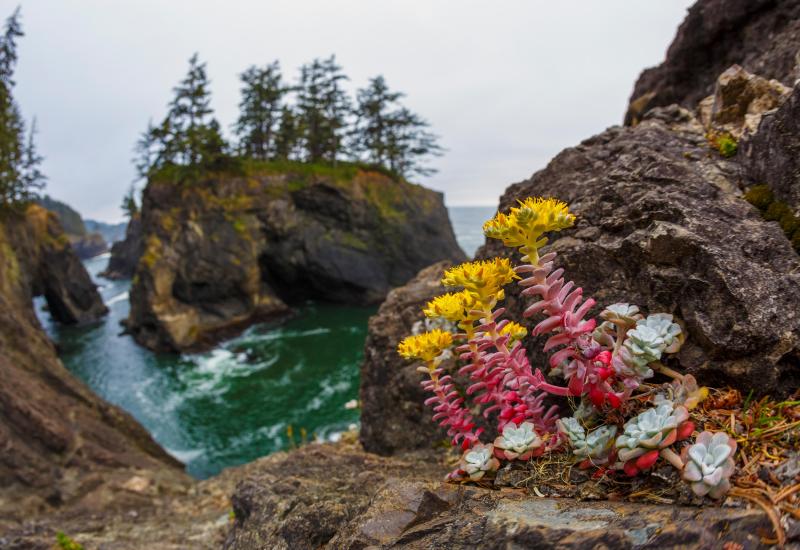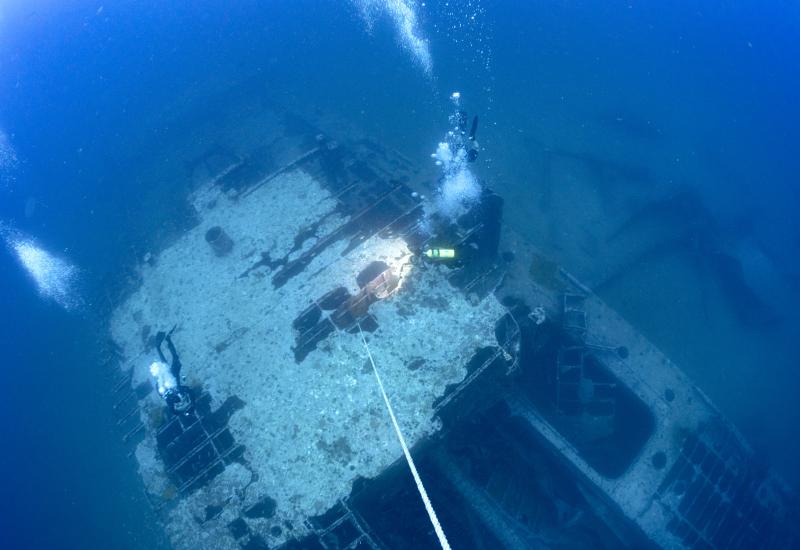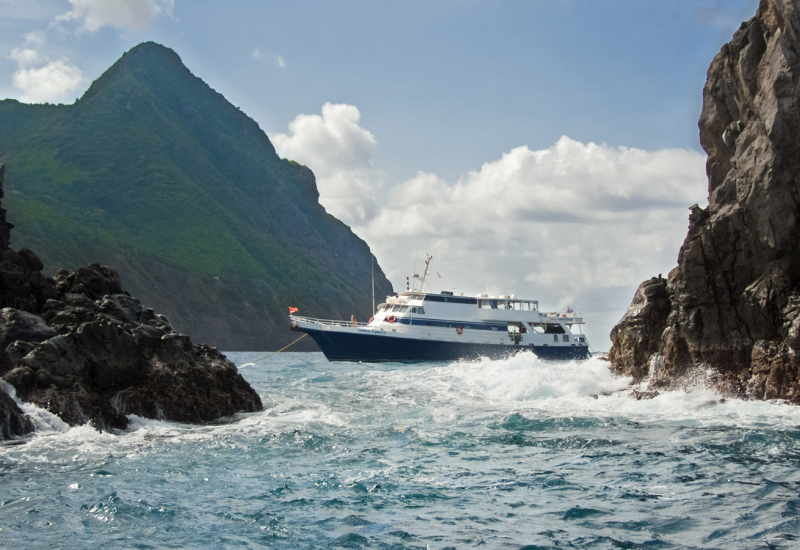Catalina Island
 |
| Giant black sea bass can grow to seven feet in length and tip the scales at more than 500 pounds. |
December 2002
By Todd Winner
Photography by Todd Winner
After descending alongside stalks of, fittingly, giant kelp at a dive site known as Italian Gardens, I settled on the sandy bottom at 70 feet. Moving slowly through the camouflage of towering fronds, I could make out huge shadows lurking in the distance. My pulse quickened and I made a final camera check before moving in.
The stories were true--the giant sea bass were indeed back. There was the proof, all five feet and about 350 pounds of it, getting picked clean of parasites by a squadron of juvenile senoritas.
As their name implies, giant sea bass (Stereolepis gigas) are huge. They can grow to over seven feet in length and are almost as large in girth. The largest reported fish weighed in at 563 pounds, but some researchers believe they can grow even larger. Despite their enormous size, giant sea bass are graceful swimmers and quite docile, allowing a diver within arm's reach if approached with slow, nonthreatening movements.
Giant sea bass, also commonly known as black sea bass, were once common along the California coast, but overfishing reduced them to near extinction in the 1970s. Now these fish are making an incredible comeback, thanks in part to a fishing moratorium in place since 1982.
Over the past few years, large spawning aggregations have formed from May through November on the front side of Catalina Island at sites like Italian Gardens. The giant fish are typically observed alone or in small groups even though the spawning aggregation may consist of 30 or more individuals. They spend most of their time slowly finning back and forth in the current, often near the bottom next to kelp.
As big animal encounters go, diving with giant sea bass is unique. It may lack the adrenaline-pumping action of blue-water shark dives or playful sea lion encounters, but it will leave you with a quiet sense of awe.
 |
| To get close, approach sea bass with slow, nonthreatening movements. |
Dive In: Catalina Island
LOCATION: Italian Gardens is accessible by boat from the California mainland or from Catalina's Avalon harbor.
WATER CONDITIONS: Average water temperature is 60F to 65F. Visibility ranges from 20 feet to 80 feet. Currents run from mild to strong.
DIVE PROFILE: Kelp patches are scattered around the site, which slopes from 30 to 100 feet. The giant sea bass are typically found at depths of 40 to 80 feet.
DIVE OPERATORS:
On the island: Catalina Divers Supply • (800) 353-0330, web: www.catalinadiverssupply.com. Catalina Scuba Luv • (800) 262-dive or (310) 510-7270.
From the mainland: The Great Escape • (866) dive boat, http://diveboat.com. The Sand Dollar • (877) 444-boat, www.diving.net/sanddollar.html. Bottom Scratcher • (714) 963-4378, www.bottomscratcher.com. The Sundiver • (800) 555-9446, www.sundiver.net. The Pacific Star • (310) 921-9210, www.pacificstardiving.com. Peace • (866) 984-2025, www.peaceboat.com. Psalty • (310) 714-0548, www.psaltyadventures.com.
FOR MORE INFORMATION: For information on giant sea bass, visit www.pier.org/rs_seabass.html.
| Giant black sea bass can grow to seven feet in length and tip the scales at more than 500 pounds.|
December 2002
By Todd Winner
Photography by Todd Winner
After descending alongside stalks of, fittingly, giant kelp at a dive site known as Italian Gardens, I settled on the sandy bottom at 70 feet. Moving slowly through the camouflage of towering fronds, I could make out huge shadows lurking in the distance. My pulse quickened and I made a final camera check before moving in.
The stories were true--the giant sea bass were indeed back. There was the proof, all five feet and about 350 pounds of it, getting picked clean of parasites by a squadron of juvenile senoritas.
As their name implies, giant sea bass (Stereolepis gigas) are huge. They can grow to over seven feet in length and are almost as large in girth. The largest reported fish weighed in at 563 pounds, but some researchers believe they can grow even larger. Despite their enormous size, giant sea bass are graceful swimmers and quite docile, allowing a diver within arm's reach if approached with slow, nonthreatening movements.
Giant sea bass, also commonly known as black sea bass, were once common along the California coast, but overfishing reduced them to near extinction in the 1970s. Now these fish are making an incredible comeback, thanks in part to a fishing moratorium in place since 1982.
Over the past few years, large spawning aggregations have formed from May through November on the front side of Catalina Island at sites like Italian Gardens. The giant fish are typically observed alone or in small groups even though the spawning aggregation may consist of 30 or more individuals. They spend most of their time slowly finning back and forth in the current, often near the bottom next to kelp.
As big animal encounters go, diving with giant sea bass is unique. It may lack the adrenaline-pumping action of blue-water shark dives or playful sea lion encounters, but it will leave you with a quiet sense of awe.
| To get close, approach sea bass with slow, nonthreatening movements.|
Dive In: Catalina Island
LOCATION: Italian Gardens is accessible by boat from the California mainland or from Catalina's Avalon harbor.
WATER CONDITIONS: Average water temperature is 60F to 65F. Visibility ranges from 20 feet to 80 feet. Currents run from mild to strong.
DIVE PROFILE: Kelp patches are scattered around the site, which slopes from 30 to 100 feet. The giant sea bass are typically found at depths of 40 to 80 feet.
DIVE OPERATORS:
On the island: Catalina Divers Supply • (800) 353-0330, web: www.catalinadiverssupply.com. Catalina Scuba Luv • (800) 262-dive or (310) 510-7270.
From the mainland: The Great Escape • (866) dive boat, http://diveboat.com. The Sand Dollar • (877) 444-boat, www.diving.net/sanddollar.html. Bottom Scratcher • (714) 963-4378, www.bottomscratcher.com. The Sundiver • (800) 555-9446, www.sundiver.net. The Pacific Star • (310) 921-9210, www.pacificstardiving.com. Peace • (866) 984-2025, www.peaceboat.com. Psalty • (310) 714-0548, www.psaltyadventures.com.
FOR MORE INFORMATION: For information on giant sea bass, visit www.pier.org/rs_seabass.html.










